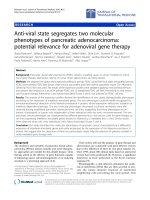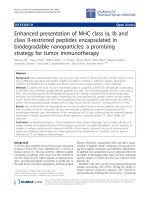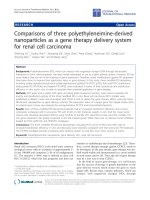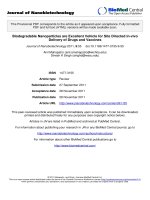Nanoparticles of biodegradable polymers for gene therapy of hepatitis b
Bạn đang xem bản rút gọn của tài liệu. Xem và tải ngay bản đầy đủ của tài liệu tại đây (1.19 MB, 114 trang )
ENGINEERING
THE
DNA:
NANOPARTICLES
OF
BIODEGRADABLE POLYMERS FOR GENE THERAPY
OF HEPATITIS B
JUNPING WANG
NATIONAL UNIVERSITY OF SINGAPORE
2006
ENGINEERING
THE
DNA:
NANOPARTICLES
OF
BIODEGRADABLE POLYMERS FOR GENE THERAPY
OF HEPATITIS B
JUNPING WANG
(B. Eng., ZJU, China)
A THESIS SUBMITTED FOR THE DEGREE OF
MASTER OF SCIENCE
GRADUATE PROGRAM IN BIOENGINEERING
NATIONAL UNIVERSITY OF SINGAPORE
2006
ACKNOWLEDGEMENT
Firstly, I would like to thank my direct supervisor Prof. Feng Si-Shen. I spent two
years in his Chemotherapy lab in completing both my second lab rotation and thesis
project. His responsibility and kindness really impressed me and his consistent trust
and help during the two and a half years benefited me a lot. Without his direction and
support, I would not be able to complete my project.
Secondly, I’d like to express my gratitude to my two co-supervisors Dr. Shu Wang
and Prof. Chen Zhiying in Stanford University. I am so honored to work with such
excellent experts in their fields. In spite of their busy schedules, they have always
been keeping an eye on my research and are always there whenever I need the advice
during all the time of research and writing of this thesis. Special thanks should also be
given to Dr. Shu Wang and his gene therapy lab for all the basic training for gene
delivery.
I am especially obliged to all the colleagues I once worked with in the two labs. Dr
Tang Guping, once being the research fellow in Dr Shu Wang’s lab, his enthusiasm on
research, his rich knowledge and his smart design of experiments help me to build up
a very solid basis for my following research. I should also say thanks to Zhang
Zhiping, Wan Yuqing and Dong Yuancai, who are all my colleagues in Prof.Feng’s lab.
I really appreciated all the discussions and technical support from them. Especially I’d
i
like to thank Ms. Tan Mei Yee, Dinah, who is the lab officer of Prof. Feng’s lab.
Without her support and help, my research project would not go through smoothly
and be completed in such a short time.
I also want to extend my appreciation to Prof. Henry Yu, who is like my good friend
and always willing to help me, Fenghao Chen, my best GPBE friend in Singapore,
always encouraged me and struggle with me especially in my final research life and
thesis writing.
Finally, I want to thank my family members my father, mother and brother. Special
thanks should also be given to my dearest friends Dan Xu and Ying Liu. Their support
to me provides a persistent inspiration for my life.
ii
TABLE OF CONTENTS
ACKNOWLEDGEMENT............................................................................................i
TABLE OF CONTENTS........................................................................................... iii
SUMMARY .................................................................................................................vi
LIST OF FIGURES AND TABLES ....................................................................... viii
LIST OF SYMBOLS ...................................................................................................x
Chapter 1 Introduction................................................................................................1
1.1 RNAi for the treatment of Hepatitis B Virus ...................................................1
1.2 Vectors for RNAi delivery..................................................................................4
1.3 Biodegradable nanoparticles for RNAi delivery .............................................5
1.4 TPGS application for drug delivery .................................................................6
1.5 TPGS inhibition of P-gp and its application in gene delivery ........................7
1.6 Objective……………………………………………………………………….8
1.7 Scope…………………………………………………………………………..10
Chapter 2 Literature Review ....................................................................................14
2.1 Gene delivery ....................................................................................................14
2.1.1 Overview of gene therapy..........................................................................14
2.1.2 Hurdles for gene therapy...........................................................................15
2.1.3 Systems for gene delivery ..........................................................................16
2.2 Viral vectors for gene delivery…………………………………………….....17
2.3 Non-viral vectors for gene delivery.................................................................19
2.3.1 Barriers for gene delivery systems ...........................................................19
2.3.2 Cationic liposomes .....................................................................................20
2.3.3 Cationic polymers………………………………………………………...21
iii
2.4 Typical cationic polymeric vectors for gene delivery……………………….23
2.4.1 PLL..............................................................................................................23
2.4.2 Dentrimers. .................................................................................................26
2.4.3 Chitosan ......................................................................................................30
2.4.4 PEI...............................................................................................................34
2.5 PLA and PLGA based biodegradable nanoparticles………………………43
2.6 Summary………………………………………………………………………47
Chapter 3 Mateirals and Methods............................................................................48
3.1 Nanoparticles for RNAi delivery.....................................................................49
3.1.1 Materials .....................................................................................................49
3.1.2 Cell culture .................................................................................................50
3.1.3 Nanoparticle preparation..........................................................................50
3.1.4 Characterization of nanoparticles ............................................................51
3.1.5 Gel retardation assay.................................................................................53
3.1.6 Nanoparticles mediated transfection with siRNAs .................................53
3.1.7 Cell cytotoxicity assay................................................................................54
3.2 TPGS enhancement for gene transfecion efficiency......................................54
3.2.1 Materials .....................................................................................................54
3.2.2 Cell culture .................................................................................................56
3.2.3 Preparation of DNA/ PEI25kd complexes ...............................................57
3.2.4 Characterization of PEI/DNA complex through Atomic force
microscopy ...........................................................................................................57
3.2.5 In vitro gene transfer .................................................................................58
3.2.6Quantitative study of cellular uptake of fluorescent PS nanoparticles..59
3.2.7 Confocal laser scanning microscopy (CLSM) .........................................60
3.2.8 Cell cytotoxicity ........................................................................................60
Chapter 4 Results and discussion .............................................................................62
4.1 Nanoparticles for RNAi delivery.....................................................................62
4.1.1 Preparation and the particle size of the nanoparticles ...........................62
4.1.2 Surface morphology and zeta potential of the nanoparticles.................64
4.1.3 Gel Retardation assay................................................................................69
4.1.4 Inhibition of HBsAg expression................................................................70
iv
4.1.5 Cell viability assay......................................................................................72
4.1.6 Nanoparticles mediated transfection with siRNAs .................................72
4.1.7 Cell cytotoxicity assay................................................................................72
4.2 Discussion ........................................................................................................73
4.3 TPGS enhancement for gene transfecion efficiency......................................75
4.3.1 Particle size and Zeta potential effect ......................................................75
4.3.2 PEI-25kd mediated in vitro gene delivery co administered with TPGS76
4.3.3 Cellular Uptake Enhancement mediated by TPGS ................................77
4.3.4 Cytotoxicity of TPGS co administered PEI 25kd....................................80
4.3.5 GFP expression in MDCK cell line...........................................................82
4.4 Discussion ........................................................................................................82
Chapter 5 Conclusions and Recommendations.......................................................85
REFERENCES...........................................................................................................86
v
SUMMARY
This thesis is aiming to apply polymeric nanoparticle techniques to the gene therapy
area. It combines principles from gene delivery, nanotechnology and polymer
chemistry in order to improve the current polymeric vectors for gene delivery by
investigating and evaluating the novel polymeric based gene delivery systems for
plasmid DNA delivery as well as the delivery of short interference RNAi.
Two independent research topics have been developed under the whole scheme of
polymeric nanoparticles for gene delivery. One is about the evaluation of
biodegradable nanoparticles as the RNAi gene delivery systems and the other one is
regarding investigating the enhancement of polymer mediated gene transfection by
co-administration of Vitamin E d-a-tocopheryl polyethylene glycol 1000 succinate
(Vitamin E TPGS).
In my first research topic, biodegradable nanoparticles acted as the RNAi delivery
vector. We constructed nanoparticles by two different biodegradable polymers
formulated respectively from poly(D, L –lactide -co-glycolide) PLGA and Methoxy
poly(ethylene
glycol)-poly(lactide)
(MPEG-PLA),
with
chitosan
and
poly(ethylenimine) (PEI) as the two surfactants modifying the surface of
nanoparticles. By investigating both of the chemical and physical characterization of
the four types of nanoparticles and conducting the biological assays, we evaluated and
vi
compared their capacities as the vector for carrying the double strand RNA (dsRNA)
delivery system. Besides this, we also studied different nanoparticles fabrication
methods to explore the best suitable one aiming to achieve the most highly
transfection efficiency by optimizing the factors which affected the delivery process.
Our final results show that PEI 25kd coating yielded the more positively charged
nanoparticles with higher DNA binding capacity and higher in vitro gene transfection
efficiency. MPEG-PLA/PEI nanoparticles with the smallest size demonstrated the
highest transfection efficiency.
We also extend the application of TPGS from traditional drug delivery to the gene
delivery area by applying it in gene transfection. Our results show that it can enhance
the transfection efficiency especially for some P-glycoprotein (P-gp) over expressing
cells. Several cell lines, which include Polarized epithelial cells (Madin Darby canine
kidney) MDCK, CaCO2 cells (a human colon adenocarcinoma cell line) and NIH 3T3
(a mouse fibroblast cell line) cells, were transfected with PEI25kd/DNA complex
blended with different concentrations of TPGS (PEI/TPGS). Transfection efficiency
of those cells was proved to be several folds higher than pure PEI 25kd in a dose
dependant manner. NIH3T3 cells were used as the negative control and were found no
obvious enhancement. The results suggest that TPGS might be of great potential for
the oral gene delivery and brain gene delivery because TPGS facilitate the
DNA/vector complex to cross the gastrointestinal (GI) barrier and blood brain barrier,
thus can benefit oral gene delivery and brain gene delivery.
vii
LIST OF FIGURES AND TABLES
Fig.2.1 Basic components of cationic lipids (DC-Chol) and (DOTMA)
Fig.2.2 Structure of the commonly used cationic polymers
Fig.2.3 Dendrimer structure
Fig.2.4 Structure of Linear and Branched PEI
Fig.2.5 Strategies for the PEGylation of PEI/DNA polyplexes
Fig.4.1. FESEM images of polymeric nanoparticles
Fig.4.2 XPS spectrum of PLGA nanoparticles with PEI25kd coating a. the whole
spectrum b. the nitrogen peak
Fig.4.3. Gel electrophoresis of the RNA and nanoparticles
Fig.4.4 Effects of SiRNA carried by four nanoparticles in PLC/PRF/5 cells
Fig.4.5 Cell viability of nanoparticles in the PLC/PRF/5 cells after treatment with
RNA/Polymer complex
Fig.4.6 AFM image of PEI25kd/DNA complexes (N/P ratio=10:1)
Fig.4.7 TPGS enhancement of PEI 25kd mediated gene transfection for MDCK cell
lines
Fig.4.8 Effect of TPGS enhancement on cellular uptake by MDCK CACO2, NIH3T3
cells of polystyrene nanoparticles
Fig.4.9 Cell cytotoxicity assay of TPGS mediated PEI/DNA complex
Fig.4.10 GFP expression in MDCK cells after transfection
Table 2.1 Ligands used to target PEI/DNA complexes
viii
Table 4.1 Size, zeta potential, of four PLGA nanoparticles with PEI25kd and chitosan
surface modified
Table.4.2 XPS analysis of surface element of PLGA nanoparticles and MPEG-PLA
nanoparticles with PEI 25kd and chitosan as the surfactants
ix
LIST OF SYMBOLS
PLGA
Poly (D, L –lactide-co-glycolide)
MPEG-PLA
Methoxy poly (ethylene glycol)-poly (lactide)
PVA
Polyvinyl acetate
PEI
Poly(ethylenimine)
PS
Polystyrene
HBV
Hepatitis B virus
CTL
Cytotoxic T lymphocyte
HLA
Human leukocyte antigen
HBsAg
Hepatitis B S antigen
DsRNA
Double strand RNA
SiRNA
short interference RNA
FESEM
Field Emission Scanning Electron Microscopy
AFM
Atomic Force Microscopy
CLSM
Confocal laser scanning microscopy
XPS
X-ray photoelectron spectroscopy
ELISA
Enzyme-linked Immunosorbent Assay
MTS
Mitochondrial reduction of tetrazolium salts into soluble dye
PBS
Phosphate buffered saline
DMEM
Dulbecco’s modified Eagle’s medium
FBS
Fetal bovine serum
x
DMSO
Dimethyl Sulfoxide
BBB
Blood brain barrier
GI
Gastrointestinal barrier
MDCK
Madin-Darby Canine Kidney
HBSS
Hank’s balanced salt solution
TPGS
Vitamin E d-a-tocopheryl polyethylene glycol 1000 succinate
GFP
Green fluorescent protein
P-gp
P-Glycoprotein
PTGS
Post-transcriptional gene silencing
xi
Chapter 1 Introduction
1.1 RNAi treatment for hepatitis B virus
Hepatitis B is one of the major diseases and a serious public health problem in the
world, especially in China. There are two billion people in the world who have been
infected with the hepatitis B virus (HBV), and more than 350 million having life-long
infections[1]. These chronically infected persons are at high risk of death from
cirrhosis of the liver or even liver cancer, which kill about one million persons each
year. Although Hepatitis B vaccine has been found 95% effective in preventing
chronic infections from developing, it cannot cure chronic hepatitis. It is estimated
that every year approximately a million people die from HBV related diseases
worldwide [2].
Hepatitis B virus is a double stranded DNA virus and it causes chronic infection of
liver because this virus can self replicate according to its template to form new viruses,
which then infect the new hepatocytes [3]. The long time infection of this disease is
the result of the interaction between the virus and the immune system of the host
patient. The human cytotoxic T lymphocyte (CTL) mediated immune response
against HBV antigen results in the apoptosis of the hepatocytes and thus leads to the
permanent damage of human liver.
1
Many drugs have been developed in the treatment of chronic hepatitis B disease and
among all the drugs, alfa-interferon (IFN-α) and lamivudine are the two most widely
used drugs in clinical applications[4]. IFN-α possesses many ideal properties as the
drug for chronic hepatitis B. It has both antiviral and immunomodulating effects. It
may inhibit viral entry into hepatocytes; activate viral ribonuclease to inhibit HBV
replication. It may also enhance CTL activity, stimulate natural killer cell activity and
amplify human leukocyte antigen (HLA) class I protein on infected cells. However,
IFN-α has poor therapeutic effect for those with higher HBV-DNA level and
immunosuppressed patients. Lamivudine, acting as a directive antiviral agents, is a
nucleoside analogue with potent inhibitory effects on HBV polymerase/reverse
transcriptase activity[5]. Besides its profound suppressive effect, lamivudine may also
restore the immune response of the patient to HBV and lamivudine treatment could
overcome the CTL hypo responsiveness in chronic hepatitis B. The main
disadvantage of this drug is the drug-resistance and drug durability because
lamivudine therapy can only transiently block the synthesis of the new virus and
prolong treatment is necessary for patients. One character of drug-resistance is the
mutations of HBV which might emerge after six to nine months of lamivudine
therapy and their occurrence incidence increases as the therapy time continues[6].
Recently, antisense technology of gene therapy brings hope to the treatment of
hepatitis B diseases. Nucleic acid-based drugs, such as antisense
oligodeoxynucleotides and ribozymes, provide another approach towards the
treatment of chronic HBV infection.
2
Gene therapy is a rapidly advancing field with great potential for the treatment of
diseases, which differs from other medical treatment by treating the cause of diseases
rather than the symptoms [7]. Traditional gene therapy refers to the gene transfer into
experimental animals or patients resulting in generalized or tissue-specific expression
that may allow precise in-vivo manipulation of biological processes to cure diseases
by directly removing their causes, that is, by correcting, adding and replacing the
genes. Recently, with the development of current antisense therapeutic technology,
short interference RNA (RNAi) as a new gene medicine show great potential for the
successful treatment of cancer and some virus infected diseases. RNA interference
(RNAi) is the process of endogenous cellular post transcriptional gene silencing
induced by double stranded RNA that is homologous in sequence to the gene being
suppressed [8]. RNA interference has been used as a research tool to control the
expression of specific genes in numerous experimental organisms and has potential as
a therapeutic strategy to reduce the expression of problem genes in many therapeutic
systems since people first observed this phenomena in C. elegans [9]. People initially
used long dsRNA and found it could induce the interferon response which would lead
to the degradation and inhibition of mRNA translation [10, 11]. Subsequent study
showed that the RNAi pathway involved the generation of an important sequence
specific molecule which was called short interference RNA (siRNA) [12] and later on
short interference RNA was shown to induce post-transcriptional gene silencing
(PTGS) without causing any interferon response[11] and this has led to the
widespread application of introducing chemically synthesized short interference RNA
3
to the target organisms. Recent progress demonstrated that chemically modified
siRNA showed improved efficacy of siRNA and better persistence of in vivo activity.
All these formal and current breakthrough shows that siRNA might be great potential
for the clinically therapeutic approach. However, the therapeutic effect was hindered
by the development of delivery systems.
1.2 Vectors for RNAi delivery system
Basically, ideal delivery systems should not only stabilize siRNA stabilization and
protection against degradation through nucleases but also enhance their delivery into
cells. In addition, such delivery vehicle should be administered efficiently, safely, and
repeatable. Several efforts have investigated cationic lipids and polymers initially
developed for plasmid DNA where internalization is by non-specific electrostatic
interactions [13, 14] which is similar with traditional gene delivery strategy. However
there is much difference between the two delivery strategies. Firstly, they have
different delivery destinations: DNA delivery systems must overcome the nucleus
barrier [15] to deliver their vehicle into cell nucleus; while as the exogenous delivery
system, the task of RNAi delivery system is much easier because the RNA
interference phenomena occurred outside cell nucleus. Secondly, although both of
these delivery systems utilize cationic agents, materials for the two delivery systems
are different especially for the cationic polymers. However, current research into
delivery of siRNA itself is still at a preliminary stage. There is little report in the
literature concerning the RNAi delivery system. Most of the delivery systems people
4
used for RNAi delivery are from the gene delivery system such as the cationic
liposome/lipid systems and cationic polymers. For example, lipofectamine 2000[16]
is a commercially available cationic lipid which has been used for the RNAi delivery
with high gene transfection efficiency for the in vitro assay. However, the toxic nature
and poor in vivo performance and poor stability of this kind of cationic lipid made it
impossible for its further application as the clinical drug delivery system. In order to
increase the circulation time of the RNAi based drugs, polyethylene glycol (PEG)
group was conjugated to the liposome for stealth property [17]. People also developed
cationic polymers such as the low molecular weight poly(ethylenimine) (PEI) [18]
with low cell cytotoxicity comparable to the branched higher molecular weight[19]
PEI 25kd
because the synthetic siRNA is small enough to be condensed by the low
charge density polymers.
1.3 Biodegradable nanoparticles for RNAi delivery
Recently, much attention was given to the application of polymeric nanoparticles to
the drug and gene delivery because biodegradable nanoparticles can safely transport
the genetic materials without exhibiting any toxicity and immune responses, and can
be produced on a large scale. PLGA nanoparticles initially were mainly used to
encapsulate the plasmid DNA by double emulsion technique after it was demonstrated
to have the endolysosomal escaping property[19, 20]. Plasmid DNA entrapped in the
PLGA core by this method showed a sustained release property[21]. Later on, another
5
strategy was developed that PLGA nanoparticles were modified by some cationic
surfactants to display a positively charged surface allowing DNA binding on the
surface of the nanoparticles through electrostatic interactions. These surfactants
include cetyltrimethylammonium bromide (CTAB), poly(ethylenimine) (PEI),
chitosan and poly(2-dimethylamino) ethyl methacrylate (pDMAEMA) polymers[22].
The cationic nanoparticles were shown to efficiently complex with DNA.
1.4 TPGS application in drug delivery
Vitamin E TPGS, d-a-tocopheryl polyethylene glycol 1000, as the only water-soluble
derivative of Vitamin E, was initially used as a vitamin E supplement especially for
patients with fat malabsorption syndromes [23-28].TPGS does not depend on fat
absorption for uptake into intestinal cells due to its amphiphillic property because it
has a relatively low critical micelle concentration, 0.02wt%, thus it could make the
need for bile acids for vitamin E absorption eliminated by forming the micelle
solutions at low concentrations[27]. Later on, TPGS was reported to function as an
inhibitor of P-glycoprotein (P-gp), the multi drug resistance reporter [29-31] and
TPGS was further used as an absorption and bioavailability enhancer for certain
water-insoluble drugs. For example, researchers [32] demonstrated the effect of
vitamin E-TPGS on the enhancement solubility and permeability of amprenavir, a
potent HIV protease inhibitor. Researchers found a significant increase in
cyclosporine (CsA) under the plasma concentration in-time-curve (AUC) when
co-administered TPGS [33-36]; the co-administration of TPGS with many anticancer
6
drugs such as doxorubicin[29], vinblastine, paclitaxol, and colchicines also shows to
enhance the cytotoxicity of these drugs. Recently development of TPGS tends to be
the utilization as the surfactant [37-40] in some particulate and micelle [41]delivery
systems for some anticancer drugs and protein drugs. All these results suggest that
TPGS might be great potential as a novel adjuvant or surfactant in combination with
an appropriate delivery system.
1.5 TPGS inhibition of P-glycoprotein and its application in gene
delivery
Previous studies show that TPGS enhancement of drug absorption was probably
mainly attributed to two reasons. One is its micelle formation would result in
improved hydrophobic drug solubilization through its amphiphilic property , the other
is due to its inhibition property of P-glycoprotein, which is confluent in many tissue
including the intestine, liver, kidney, testis, placenta and endothelial cells comprising
the blood brain barriers [42]. And P-glycoprotein, function as an ATP-dependent drug
efflux pump in these tissues to remove chemically unrelated drugs, has also been
implicated as a primary cause of multi drug-resistance in tumors [43]. Expressed on
the apical surfaces of epithelial cells in major drug eliminating organs in the body,
P-gp is responsible for secreting passively diffused drug out of the cell[44]. It uses
energy gained from ATP hydrolysis to transport an assortment of structurally
unrelated compounds out of cells. The drugs resisted by P-glycoprotein vary widely in
their structure and people trying to propose hypothesis and set up models [45-48] to
7
understand the complex interactions that substrates and inhibitors have with the efflux
transporter P-glycoprotein. People developed many substrates for P-glycoprotein and
many inhibitors to bypass the efflux system, and so far the investigation about
P-glycoprotein and its inhibitors showed that one common structural feature of these
substrates identified for P-glycoprotein is their relatively hydrophobic, amphipathic
nature [45, 46] and P-glycoprotein mainly limit passive permeability, that means
P-glycoprotein limits absorption of only moderately permeable compounds[48,
49].By inhibiting the resistance of P-glycoprotein, TPGS acting as the adjuvant in
numerous delivery systems might enhance the permeable ability of nanoparticles
containing drugs or drugs themselves.
1.6 Objective
In our present study, we tried to apply this strategy to the delivery of the dsRNA to
evaluate its potential as the RNA delivery system. We have been investigating four
types of biodegradable nanoparticles formulated respectively from poly(D, L
–lactide-co-glycolide) PLGA and Methoxy poly(ethylene glycol)-poly(lactide)
(MPEG-PLA), as the vector of double strand RNA delivery system. These
nanoparticles were easily obtained by nanoprecipitation method and solvent
evaporation technique and modified by the surface coating with cationic polymers.
PEI and chitosan were chosen as the two surfactants because of their cationic property
to bind the RNA on the surface of nanoparticles. Besides this, the presence of chitosan
which was known for its recognized mucoadhesive and permeability enhancing
8
properties on the surface was supposed to increase the cellular uptake of nanoparticles
[50].We also investigate the size effect on the RNA transfecion efficiency. The four
types of cationic nanoparticles (PLGA/PEI, PLGA/chitosan, MPEG-PLA/PEI, and
MPEG-PLA/chitosan) were compared with regards to chemical physical properties
and RNA binding capabilities, cell cytotoxicity property and in vitro transfection
efficiency.
Furthermore, we have also studied the TPGS effect on the cellular uptake of
polymer/DNA nanocomplexes and the effect on the gene transfection to
P-glycoprotein positively expressed cells. Madine–Darby Canine kidney (MDCK),
Caco-2 monolayer were used as cell models for the P-glycoprotein positively
expressed cell lines in contrast with NIH3T3 cells which acted as the negative control.
In this study, we utilized TPGS with different concentrations blending with PEI/DNA
complex and found that the transfection efficiency for the P-glycoprotein positively
expressed cells was improved significantly co administered with TPGS. Moreover, we
further studied the TPGS enhancement for cellular uptake of polystyrene
nanoparticles from the size 20nm to 500nm. The purpose of this study was mainly to
understand the correlation of TPGS effect on the nanoparticles internalization with
nanoparticles size and its effect on the epithelial permeability of those gene delivery
vectors, which could aid in the future design of polymeric vehicles for gene delivery
via the gastrointestinal tract.
9
1.7 Scope
This thesis reports on the new application of polymeric nanoparticles on RNAi
delivery systems and the investigation of TPGS as a gene transfection enhancer for
the polymeric mediated gene transfection.
Chapter 1 introduction presented the background and objective of this project. This
thesis mainly focuses on the improvement of polymeric gene delivery system and the
application of biodegradable nanoparticles to deliver the RNAi for hepatitis B virus.
After introduction of a novel strategy RNAi for treating hepatitis B virus disease and
the current challenge for RNAi delivery, the objective proposes a novel biodegradable
polymeric delivery system and explores the enhancing property of TPGS for gene
delivery.
Chapter 2 reviewed related literature on gene delivery vectors including viral vectors
and non-viral vectors which cover most of the current polymers for gene delivery.
Finally, the author discussed the application of biodegradable nanoparticles for gene
delivery which is viewed as the most promising field for current drug and gene
delivery. Nanoparticulate delivery system is superior to traditional vectors in terms of
biodegradability, ease of chemically modified property and sustained release property.
.
Chapter 3 described the detailed fabrication methods of cationic PLGA and
MPEG-PLA nanoparticulate system, the thorough characterization techniques for the
10
physical and chemical property of nanoparticles, DNA loading experiment, and all the
related cell experiments for evaluating the in vitro delivery performance of this
nanoparticulate system.
In Chapter 4, the results of two experiments were presented separately under the
whole scheme of applying and improving the polymeric based gene delivery system.
The results of nanoparticulate system for RNAi delivery show that our cationic
MPEG-PLA/PEI nanoparticles can sufficiently bind with RNAi and effectively inhibit
the production of virus protein, thus shows great potential for treating the hepatitis B
virus disease. In the discussion part of the first experiment, the author also analyzed
the physical property effect on the transfection efficiency such as size and zeta
potential. The results of the other TPGS mediated gene transfection experiment show
that DNA/polymer complex blending with TPGS can enhance the transfection
efficiency especially for some P-glycoprotein (P-gp) over expressing cells. In the
discussion of this experiment, the author discussed the possible reason of the
enhancing property of TPGS and the further research is suggested to be done in order
to explore more about the interaction between TPGS and P-gp and cellular uptake
mechanism.
Chapter 6 covers the conclusion and recommendation. The conclusion was drawn that
this cationic biodegradable nanoparticle bears promising application in RNAi delivery
and TPGS might be a good adjuvant for polymeric based gene delivery system.
In
11
the future recommendation, a serial of follow-up works were proposed including
investigating the specific mechanism that how TPGS enhance the cellular uptake and
transfection efficiency and applying the TPGS or TPGS-PLA copolymer synthesized
by our lab to the gene delivery system.
12









